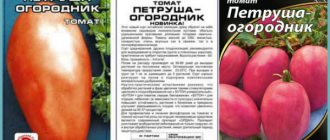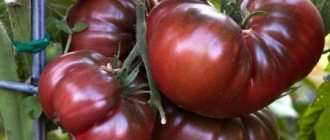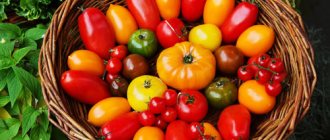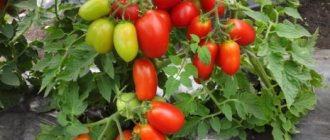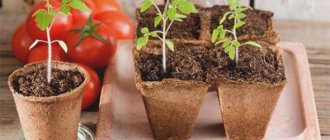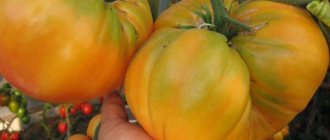Productivity
The average predicted yield for the Ogorodnik tomato is 7.4-9.5 kg/m2. To obtain good fruiting, it is important to follow the agricultural techniques for growing this crop.
In which regions of Russia can the Ogorodnik tomato be grown?
The Ogorodnik tomato is valued for its ability to obtain a good harvest when grown in a variety of climatic conditions.
Ural
In a sharply continental, variable climate, it is necessary to use seedlings. Mostly the Ogorodnik tomato is planted in greenhouses.
Siberia
The Ogorodnik tomato variety is suitable for Siberian conditions if you use seedling technology. Greenhouses are usually set up so that seedlings take root faster. Once warmer weather has established, mid-season tomatoes can be transplanted onto beds, providing for the installation of a temporary film structure over them.
Moscow region and central Russia
If the goal of cultivating the Ogorodnik tomato in areas of central Russia is to obtain fruits ripened on the bushes, then the seedlings are moved to greenhouses in the first ten days of May. Later crops can be grown in open beds. Seedlings should be planted in them in early June.
Southern regions of Russia
Using the seed method, the mid-season tomato “Ogorodnik” is successfully cultivated in the south. Sowing activities are carried out in April. During this period, the soil contains enough moisture for the successful formation of seedlings.
Harvesting
Thanks to gradual ripening, you can enjoy the taste of fresh tomatoes of the Ogorodnik variety for a fairly long period of time. Despite the density of the skin, for transportation over long distances it is better to remove unripe fruits. For them to turn red, it is enough to keep them in the sun for several days. You can harvest in any available container. It is better to store in a cool place.
Read more about how to properly store tomatoes at home.
The Ogorodnik variety is the optimal solution for growing in different regions. If you take into account all the care features, then after a little more than three months, you can harvest a lot of delicious tomatoes.
Planting tomato seeds
To obtain viable seedlings, sowing activities should begin in March-April. This will allow the seedlings to reach the required 55-65 days of age by the time they are planted in a permanent place.
Seed preparation
To ensure good germination, seed material is calibrated, discarding small, dry, damaged specimens with signs of disease.
Disinfection is required for seed that was purchased on the market or harvested in your own garden. Immerse the grains for 25-35 minutes in a pink solution of potassium permanganate. After the procedure, you need to rinse and dry them.
To determine the fullness of the seeds, dissolve 1 tsp. fine-grained salt in a glass of slightly warmed water. Pour the grains into the liquid. After 3-5 minutes, all specimens that appear on the surface are carefully collected and discarded. The remaining immersed seeds need to be washed.
To activate subsequent growth processes, it is recommended to then soak the seeds in a stimulant for 10-12 hours.
Sowing seedlings
Tomato seeds are small in size, so it is necessary to prepare a loose nutrient substrate for sowing, which can be easily purchased at gardening stores.
You can independently combine garden and turf soil with crushed high-moor peat and compost in equal proportions. Disinfect with a pink solution of potassium permanganate.
Low seedling containers are not filled to the very top with the soil mixture. Grooves are formed on the surface. Their depth is 15-25 mm. The row spacing is 9-10 cm. The seeds are distributed, maintaining a gap of about 4 cm. They are covered with a dry substrate, and then the surface is sprayed with settled water.
Seedling containers covered with transparent material are installed in a well-lit place at +18…+20 °C. Be sure to practice daily ventilation of the indoor greenhouse. If necessary, moisten the soil. When sprouts appear, the shelter must be removed.
If you need a small number of seedlings, it is advisable to sow the tomato immediately into individual cups of 2-3 seeds.
Hardening, picking seedlings
Seedlings should be planted from common boxes when they have 2-4 leaves. Prepare small containers with fertile, breathable substrate.
In 1-2 hours, the seedlings are watered abundantly. This will allow you to remove fragile seedlings without damage. When picking, the root is lightly pinched. Then the plants are planted in local containers and watered.
Sprouts sown immediately in individual pots will not need to be pricked. In this situation, when the plants are strong enough, you will need to leave one strong shoot, and cut off the remaining shoots.
8-12 days before the planned planting, the seedlings begin to be taken out onto the loggia or veranda. The hardening interval is gradually increased. This procedure ensures good adaptation after landing in a permanent place.
Landing in the ground
Select a place for the “Ogorodnik” tomato with good lighting and protection from drafts. Avoid areas where any plants of the Solanaceae family have been grown. Swampy lowlands are not suitable.
In the autumn, the area is cleared of leaves and weeds are pulled out by the roots. To increase fertility, use well-rotted manure or compost. For 1 sq. m take 1-1.5 buckets of organic matter, which is additionally enriched with superphosphate (45-50 g). You can add ash (0.5 cup) to the nutritional composition. Then the ground needs to be plowed or thoroughly dug up.
Pests and diseases
Most diseases do not threaten Gardener's tomatoes if farmers are responsible in developing the best regime for caring for tomatoes.
The worst enemy of the variety is the nematode, which often attacks many vegetable crops. It is known that there are many varieties of this pest in the world; it is impossible to notice them with the naked eye at first. Microscopic worms reproduce quickly. For this reason, fighting nematodes is not easy. It is necessary to reliably protect the tomato from possible invasion by all available methods, from processing the seed material to applying funds at the transplantation stage.
The pest can become the main obstacle for the plant in terms of absorption of nutrients and in the process of photosynthesis. There is no point in trying to save the crop; it jeopardizes other healthy bushes. The affected plant is removed from the site.
The growth site is carefully treated. More often, the nematode affects the Ogorodnik variety in regions where winters are short and warm. It will not be difficult for such pests to overwinter in the ground while waiting for the time of planting new crops.
Growing the “Ogorodnik” variety in a greenhouse
When cultivating medium-ripening tomatoes, which include the Ogorodnik variety, it is possible to obtain high-quality ripe fruits if the seedlings are placed in a greenhouse in early May. In such conditions, it is important to follow several rules:
- In the fall, at the preparatory stage, external and internal surfaces, as well as all structures, equipment, and soil are sprayed with a disinfectant composition. A pink solution of potassium permanganate and Bordeaux mixture (1%) are used.
- Since mid-season tomatoes can be affected by late blight if the ambient humidity is high enough, it is necessary to provide regular ventilation of the greenhouse.
- To prevent damage to the stems under the weight of heavy fruits, strong, reliable trellises are installed, which will allow the developing shoots to be fixed as they develop.
- When watering, it is recommended to pour water directly onto the soil, which will avoid excessive wetting of the leaf plates. You can install your own drip irrigation system.
- Every 3-4 years in the fall, the surface soil layer in which pathogenic microorganisms accumulate is removed. Replace it with disinfected fertile soil.
Care
Parsley tomatoes are a rather unpretentious plant, but require careful attention to it and compliance with the rules of agricultural technology.
Spraying and watering
Moisturizing the soil and bushes should be done exclusively with warm and settled water. The best time for such procedures is considered to be morning or evening. Daytime watering can only be done by drip.
The interval between moistening depends solely on the weather conditions, dryness and type of soil.
If there is a lack of moisture in the soil, the flowers and ovaries that appear will begin to crumble. The best option is irrigation once every 4–5 days. The volume of one-time watering is approximately 7–8 liters per bush, without touching the trunk and foliage of the seedlings.
In dry times, as well as in hot weather, it is advisable to moisten the soil and spray the plants every day. The presented hybrid is capable of bearing fruit until frost, but in order for the tomatoes to have time to ripen before the onset of cold weather, autumn watering should be reduced as much as possible.
Top dressing
The Parsley Ogorodnik tomato, according to reviews from gardeners and photographs taken, has good yields provided that various fertilizers are provided in a timely manner.
The table provides recommendations for carrying out the specified work in a greenhouse or on an open plantation:
| Phased development of the hybrid | Deadlines | How many times to apply the mixture (depending on the condition of the fruit) | Types of substances used | Preparations and mixtures |
| Planting in the soil | May | 1–2 times | Microelements + nitrogen, phosphorus, potassium | Ammoska, preparation “Spring, Summer, Universal”, ash, humus, OMU “For peppers, tomatoes, eggplants” “Senior Tomato” |
| In 15 days | May June | 1–2 | Nitrogen + phosphorus | Nitrate, humate, superphosphate, ammonium urea, manure |
| During growth | May June | 2–3 | Potassium + phosphorus | Iodine solution, ash, superphosphate, nitroammophoska |
| At the flowering stage | May - July | 2–3 | Same components | “Senior Tomato”, “Solution”, herbal infusion, “Kemira Lux” |
| At the stage of fruit set | June July | 2–3 | Likewise | Ammofoska, "Tamaton", "Sudarushka" |
| During the fruiting period | June August | 2–3 | Phosphorus, manganese, iodine, potassium, boron | Iodine solution, ash, potassium sulfate, barnyard, "Solution". In order to accelerate the ripening of fruits, use: “Benefit”, Potassium Monophosphate, “Estrep”, copper sulfate, “Dozrevatel”, manganese sulfate |
Parsley, like other tomatoes, responds well to bird droppings. It should be kept in mind that boric acid should only be diluted with hot liquid. In sunny weather, it is recommended to reduce the amount of potassium used. To stimulate fruit formation on cloudy days, it is necessary to increase the dose of potassium fertilizers applied.
Tying up
Tomato Parsley Gardener (reviews, photos, plant productivity provide useful information about each stage of its development), grown in open ground, tends to grow greatly in breadth, so for an adult crop it is advisable to arrange a not very high, but stable support.
To avoid deformation of the bushes, experienced gardeners advise tying strong and powerful shoots with fairly heavy fruits to installed pegs.
Topping
For hybrid varieties of tomatoes, such as Parsley gardener, this procedure is carried out in order to accelerate the ripening of fruits and normalize their quantity. If this is not done, the bushes will constantly grow, forming excess vegetative mass, and the ovaries that appear may not have time to turn into ripe and full-fledged fruits during the warm season.
It is recommended to carry out this procedure in mid-June or closer to the last days of July, which depends both on the prevailing weather and on the speed of tomato development.
When a sufficient number of flower tassels have formed on the stem of the plant, you have to pinch (remove) the top of the bush. In this case, you should leave 3 sheets above each brush, the rest should be carefully broken off.
Transfer
These actions should be performed after the plants reach 2 months of age. At this time, young seedlings should be planted in open ground. During further cultivation, the hybrid does not need to be moved to other places.
Optimal conditions
After sowing, the container with the material should be left for further germination in a room with a temperature of about +18 °C. Before the first shoots appear, this indicator should be within +23... +25 °C, then - +18... +23 °C with air humidity up to 60%. Good germination of seedlings also requires 12 hours of daylight.
Containers with seedlings should be rotated periodically to provide all sprouts with sufficient light. In cloudy weather, it is advisable to have additional lighting, for which you can use UV lamps. Young seedlings are planted in soil that has warmed up to 10 °C, when the weather in the yard is warm with a temperature of +14 °C.
Reviews about the variety
According to people who grow this species, the “Ogorodnik” tomato attracts people with its excellent taste of large, juicy, sweet fruits. Gardeners value good transportability while maintaining presentation, as well as long-term storage of the harvested crop. They note simple agricultural cultivation techniques.
There are practically no shortcomings noted. Sometimes there are negative reviews associated with the possibility of late blight if prolonged rainy weather occurs during the fruiting stage.
Summer residents who grow the Ogorodnik tomato include it in the list of the most productive and promising varieties. It is usually possible to obtain a stable high yield of high-quality fruits when properly cultivated under film.
Appearance
The fruits of the Parsley gardener tomato have an original shape: it is somewhat different from the declared cylindrical one. This cylinder is not completely smooth, but has a characteristic pointed nose at the tip. The color is magnificent: it is transitional from pink to crimson, rich. In general, Parsley Gardener tomatoes look very cheerful and evoke a good mood.
The fruits of the Parsley gardener tomato do not always have the correct shape, sometimes they crack, but the color is pleasant
